Viscoelastic Properties, Rutting Resistance, and Fatigue Resistance of Waste Wood-Based Biochar-Modified Asphalt
Abstract
:1. Introduction
2. Test Material
2.1. Matrix Asphalt
2.2. Graphite and Graphite-Modified Asphalt
2.3. Biochar and Biochar-Modified Asphalt
3. Test Method
3.1. Rolling Thin Film Oven (RTFO) Test
3.2. Pressure Aging Vessel (PAV) Test
3.3. Dynamic Shear Rheometer (DSR) Test
3.4. Electron Microscope (SEM) Test
4. Results and Analyses
4.1. Analysis of Viscoelastic Properties
4.2. Analysis of Rutting Resistance
4.3. Analysis of Fatigue Resistance
4.4. Analysis of Microstructure
4.5. Statistical Analysis
5. Conclusions
- Asphalt showed more obvious viscous characteristics with increasing temperature. The addition of biochar particles promoted the improvement of the elastic components of asphalt, and it increased with the increasing amount of biochar. Compared to asphalt PG 58-28, graphite-modified asphalt, and biochar-modified asphalt of large particle size, the elastic components of biochar-modified asphalt of small particle size was higher, whose viscoelastic properties were least affected by high temperature.
- The addition of biochar increased the critical high temperature of asphalt, and the rutting resistance of biochar-modified asphalt significantly increased with the increase in biochar mixing amount. The biochar-modified asphalt had better rutting resistance at high temperature than petroleum asphalt and graphite-modified asphalt, especially for the asphalt modified with biochar of small particle size.
- The fatigue cracking resistance of asphalt reduced with the addition of biochar. However, the fatigue resistance of 2% Wd was similar to or even better than that of petroleum asphalt, and 4% Wd had a similar fatigue cracking resistance to 4% Gd. The particle size of biochar had a significant influence on the fatigue resistance of biochar-modified asphalt. The binder modified with biochar of small particle size had better fatigue cracking resistance than the asphalt modified with biochar of large particle size.
- The biochar had a rougher surface and more pores than graphite, which provided its larger specific surface area. This made it easier to bond with asphalt to form a skeleton network structure, thus forming a more stable biochar–asphalt base structure. Therefore, biochar-modified asphalt showed better rutting resistance at high temperature.
Author Contributions
Funding
Institutional Review Board Statement
Informed Consent Statement
Data Availability Statement
Conflicts of Interest
References
- Jaiswal, A.K.; Elad, Y.; Graber, E.R.; Frenkel, O. Rhizoctonia solani suppression and plant growth promotion in cucumber as affected by biochar pyrolysis temperature, feedstock and concentration. Soil Biol. Biochem. 2014, 69, 110–118. [Google Scholar] [CrossRef]
- Muñoz, E.; Curaqueo, G.; Cea, M.; Vera, L.; Navia, R. Environmental hotspots in the life cycle of a biochar-soil system. J. Clean. Prod. 2017, 158, 1–7. [Google Scholar] [CrossRef]
- Qi, L.; Pokharel, P.; Chang, S.X.; Zhou, P.; Niu, H.; He, X.; Wang, Z.; Gao, M. Biochar application increased methane emission, soil carbon storage and net ecosystem carbon budget in a 2-year vegetable–rice rotation. Agric. Ecosyst. Environ. 2020, 292, 106831. [Google Scholar] [CrossRef]
- Xu, L.; Fang, H.; Deng, X.; Ying, J.; Lv, W.; Shi, Y.; Zhou, G.; Zhou, Y. Biochar application increased ecosystem carbon sequestration capacity in a Moso bamboo forest. For. Ecol. Manag. 2020, 475, 118447. [Google Scholar] [CrossRef]
- Mukherjee, A.; Zimmerman, A.R. Organic carbon and nutrient release from a range of laboratory-produced biochars and biochar–soil mixtures. Geoderma 2013, 193–194, 122–130. [Google Scholar] [CrossRef]
- Masiello, C.; Dugan, B.; Brewer, C.; Spokas, K.; Novak, J.; Liu, Z.; Sorrenti, G. Biochar Effects on Soil Hydrology, Biochar for Environmental Management, 2nd ed.; Routledge: London, UK, 2015. [Google Scholar]
- Suliman, W.; Harsh, J.B.; Abu-Lail, N.I.; Fortuna, A.-M.; Dallmeyer, I.; Garcia-Pérez, M. The role of biochar porosity and surface functionality in augmenting hydrologic properties of a sandy soil. Sci. Total Environ. 2017, 574, 139–147. [Google Scholar] [CrossRef]
- Ali, S.; Rizwan, M.; Qayyum, M.F.; Ok, Y.S.; Ibrahim, M.; Riaz, M.; Arif, M.S.; Hafeez, F.; Al-Wabel, M.I.; Shahzad, A.N. Biochar soil amendment on alleviation of drought and salt stress in plants: A critical review. Environ. Sci. Pollut. Res. 2017, 24, 12700–12712. [Google Scholar] [CrossRef]
- Six, J. Biochar: Is There a Dark Side? 2014. Available online: https://ethz.ch/en/news-and-events/eth-news/news/2014/04/biochar-is-there-a-dark-side.html (accessed on 1 April 2014).
- Downie, A. Biochar Production and Use: Environmental Risks and Rewards. Ph.D. Thesis, University of South Wales, Newport, UK, 2011. [Google Scholar]
- An, C.; Huang, G. Environmental concern on biochar: Capture, then what? Environ. Earth Sci. 2015, 74, 7861–7863. [Google Scholar] [CrossRef]
- Brick, S.; Lyutse, S. Biochar: Assessing the Promise and Risks to Guide US Policy; Natural Resources Defense Council: NRDC Issue Paper; NRDC: New York, NY, USA, 2010. [Google Scholar]
- Cleven, M.A. Investigation of the Properties of Carbon Fiber Modified Asphalt Mixtures. Master’s Thesis, Michigan Technological University, Houghton, MI, USA, 2000. [Google Scholar]
- Yao, H.; You, Z.; Li, L.; Goh, S.W.; Lee, C.H.; Yap, Y.K.; Shi, X. Rheological properties and chemical analysis of nanoclay and carbon microfiber modified asphalt with Fourier transform infrared spectroscopy. Constr. Build. Mater. 2013, 38, 327–337. [Google Scholar] [CrossRef]
- Khattak, M.J.; Khattab, A.; Rizvi, H.R.; Zhang, P. The impact of carbon nano-fiber modification on asphalt binder rheology. Constr. Build. Mater. 2012, 30, 257–264. [Google Scholar] [CrossRef]
- Yoo, D.-Y.; Kim, S.; Kim, M.-J.; Kim, D.; Shin, H.-O. Self-healing capability of asphalt concrete with carbon-based materials. J. Mater. Res. Technol. 2018, 8, 827–839. [Google Scholar] [CrossRef]
- Norgbey, E.; Huang, J.; Hirsch, V.; Liu, W.J.; Wang, M.; Ripke, O.; Li, Y.; Annan, G.E.; Ewusi-Mensah, D.; Wang, X.; et al. Unravelling the efficient use of waste lignin as a bitumen modifier for sustainable roads. Constr. Build. Mater. 2020, 230, 116957. [Google Scholar] [CrossRef]
- Wróbel, M.; Woszuk, A.; Ratajczak, M.; Franus, W. Properties of reclaimed asphalt pavement mixture with organic rejuvenator. Constr. Build. Mater. 2021, 271, 121514. [Google Scholar] [CrossRef]
- Wang, Z.; Dai, Q.; Guo, S. Laboratory performance evaluation of both flake graphite and exfoliated graphite nanoplatelet modified asphalt composites. Constr. Build. Mater. 2017, 149, 515–524. [Google Scholar] [CrossRef]
- Liu, X.; Wu, S. Study on the graphite and carbon fiber modified asphalt concrete. Constr. Build. Mater. 2011, 25, 1807–1811. [Google Scholar] [CrossRef]
- Cong, P.; Xu, P.; Chen, S. Effects of carbon black on the anti aging, rheological and conductive properties of SWd/asphalt/carbon black composites. Constr. Build. Mater. 2014, 52, 306–313. [Google Scholar] [CrossRef]
- Gupta, S.; Kua, H.W.; Koh, H.J. Application of biochar from food and wood waste as green admixture for cement mortar. Sci. Total. Environ. 2018, 619–620, 419–435. [Google Scholar] [CrossRef]
- Akhtar, A.; Sarmah, A.K. Novel biochar-concrete composites: Manufacturing, characterization and evaluation of the mechanical properties. Sci. Total Environ. 2018, 616, 408–416. [Google Scholar] [CrossRef]
- Walters, R.C.; Fini, E.H.; Abu-Lebdeh, T. Enhancing Asphalt Rheological Behavior and Aging Susceptibility Using Bio-Char and Nano-Clay. Am. J. Eng. Appl. Sci. 2014, 7, 66–76. [Google Scholar] [CrossRef]
- Zhao, S.; Huang, B.; Ye, X.P.; Shu, X.; Jia, X. Utilizing bio-char as a bio-modifier for asphalt cement: A sustainable application of bio-fuel by-product. Fuel 2014, 133, 52–62. [Google Scholar] [CrossRef]
- Zhao, S.; Huang, B.; Shu, X.; Ye, P. Laboratory investigation of biochar-modified asphalt mixture. Transp. Res. Rec. J. Transp. Res. Board 2014, 2445, 56–63. [Google Scholar] [CrossRef]
- Dong, W.; Ma, F.; Li, C.; Fu, Z.; Huang, Y.; Liu, J. Evaluation of Anti-Aging Performance of Biochar Modified Asphalt Binder. Coatings 2020, 10, 1037. [Google Scholar] [CrossRef]
- Tarar, M.A.; Khan, A.H.; ur Rehman, Z.; Qamar, S.; Akhtar, M.N. Performance characteristics of asphalt binders modified with sunflower flour: A sustainable application of renewable resource derived material. Constr. Build. Mater. 2020, 242, 118157. [Google Scholar] [CrossRef]
- Thomas, K.M.; Mathew, N.V.; Rajalekshmi, P.R.; Kumar, R.S.; Koshy, R.Z. Water Quality and Performance Assessment of Porous Asphalt Mix Modified Using Charcoal Powder. J. Sustain. Eng. Proc. Ser. 2019, 1, 123–136. [Google Scholar] [CrossRef]
- AASHTO. Standard Specification for Performance-Graded Asphalt Binder (M320-10); American Association of State Highway and Transportation Officials: Washington, DC, USA, 2013. [Google Scholar]
- Zhang, R.; Dai, Q.; You, Z.; Wang, H.; Peng, C. Rheological Performance of Bio-Char Modified Asphalt with Different Particle Sizes. Appl. Sci. 2018, 8, 1665. [Google Scholar] [CrossRef] [Green Version]
- AASHTO. Effect of Heat and Air on a Moving Film of Asphalt Binder (Rolling Thin-Film Oven Test); American Association of State Highway and Transportation Officials: Washington, DC, USA, 2013. [Google Scholar]
- AASHTO. Standard Practice for Accelerated Aging of Asphalt Binder Using a Pressurized Aging Vessel (PAV); American Association of State Highway and Transportation Officials: Washington, DC, USA, 2013. [Google Scholar]
- AASHTO. Standard Method of Test for Determining the Rheological Properties of Asphalt Binder Using a Dynamic Shear Rheometer (DSR) (T 315-12); American Association of State Highway and Transportation Officials: Washington, DC, USA, 2013. [Google Scholar]
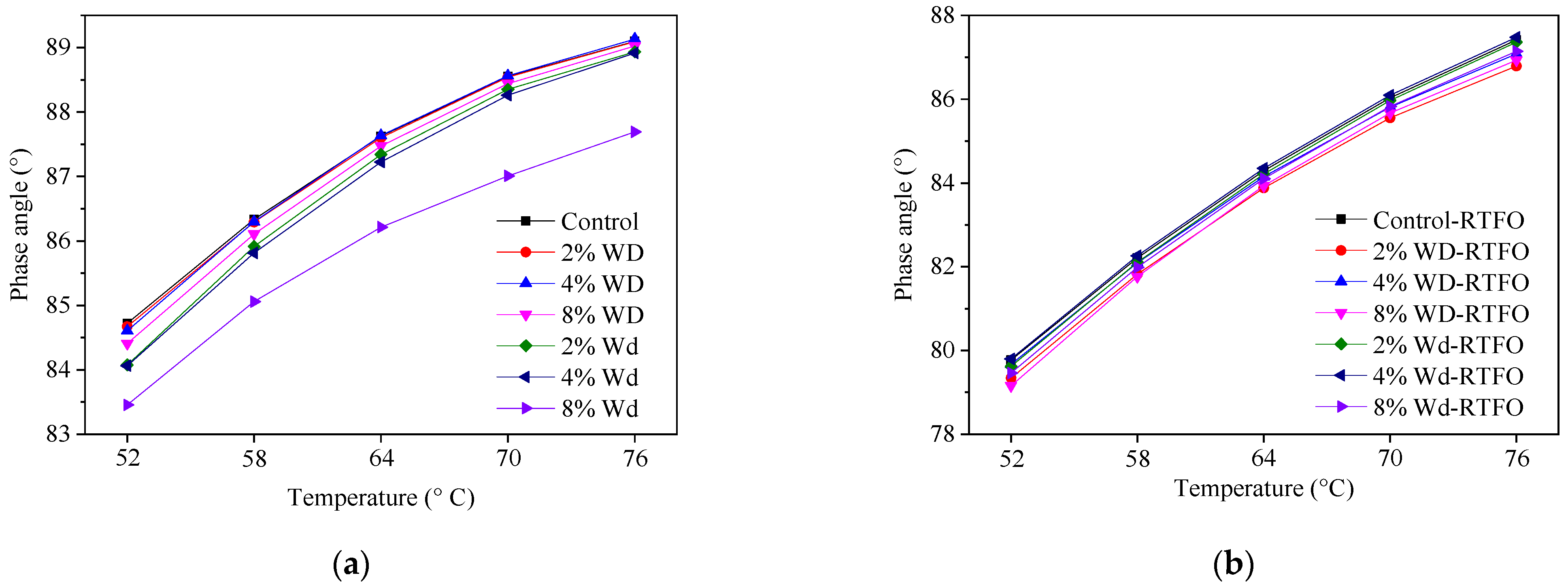
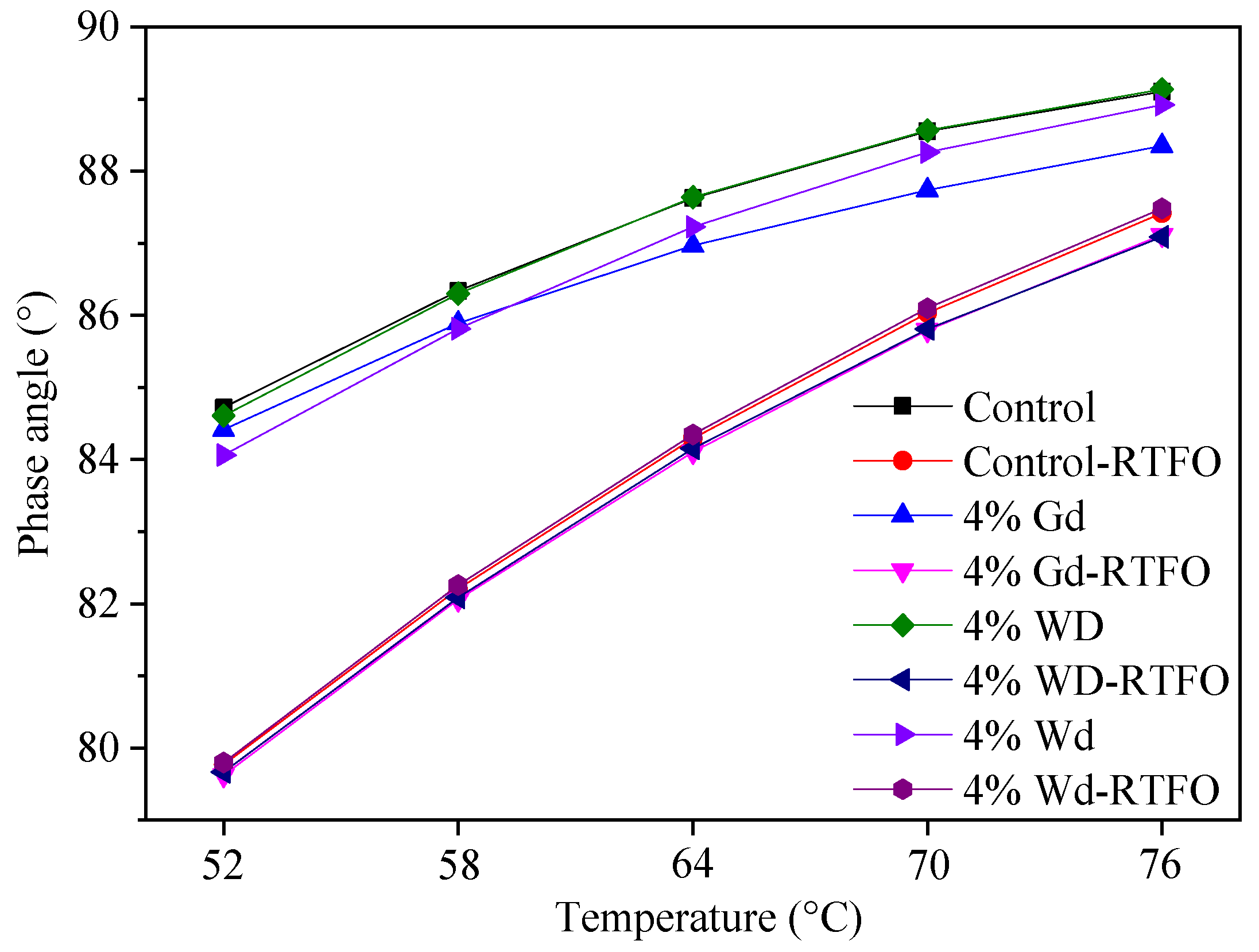
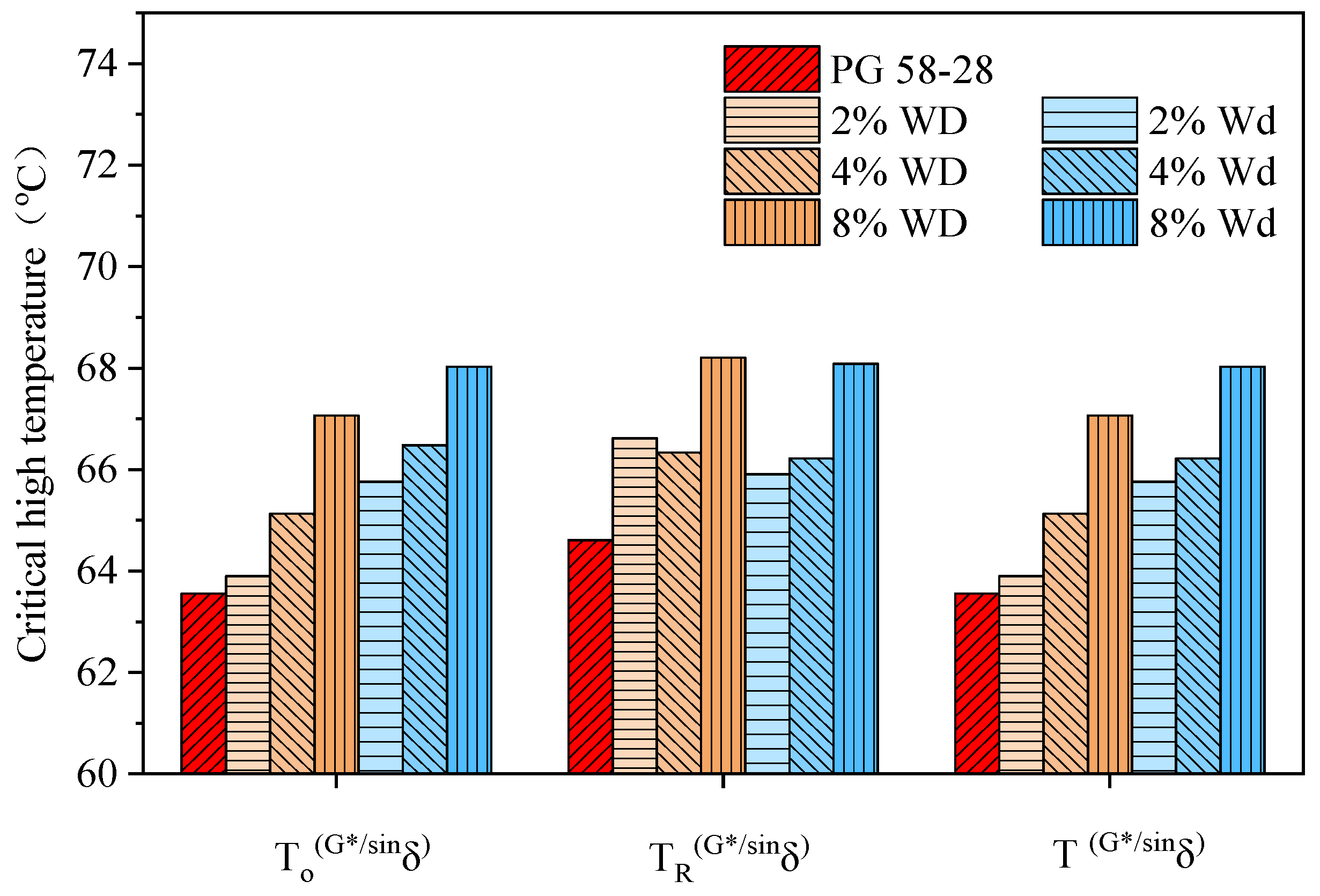
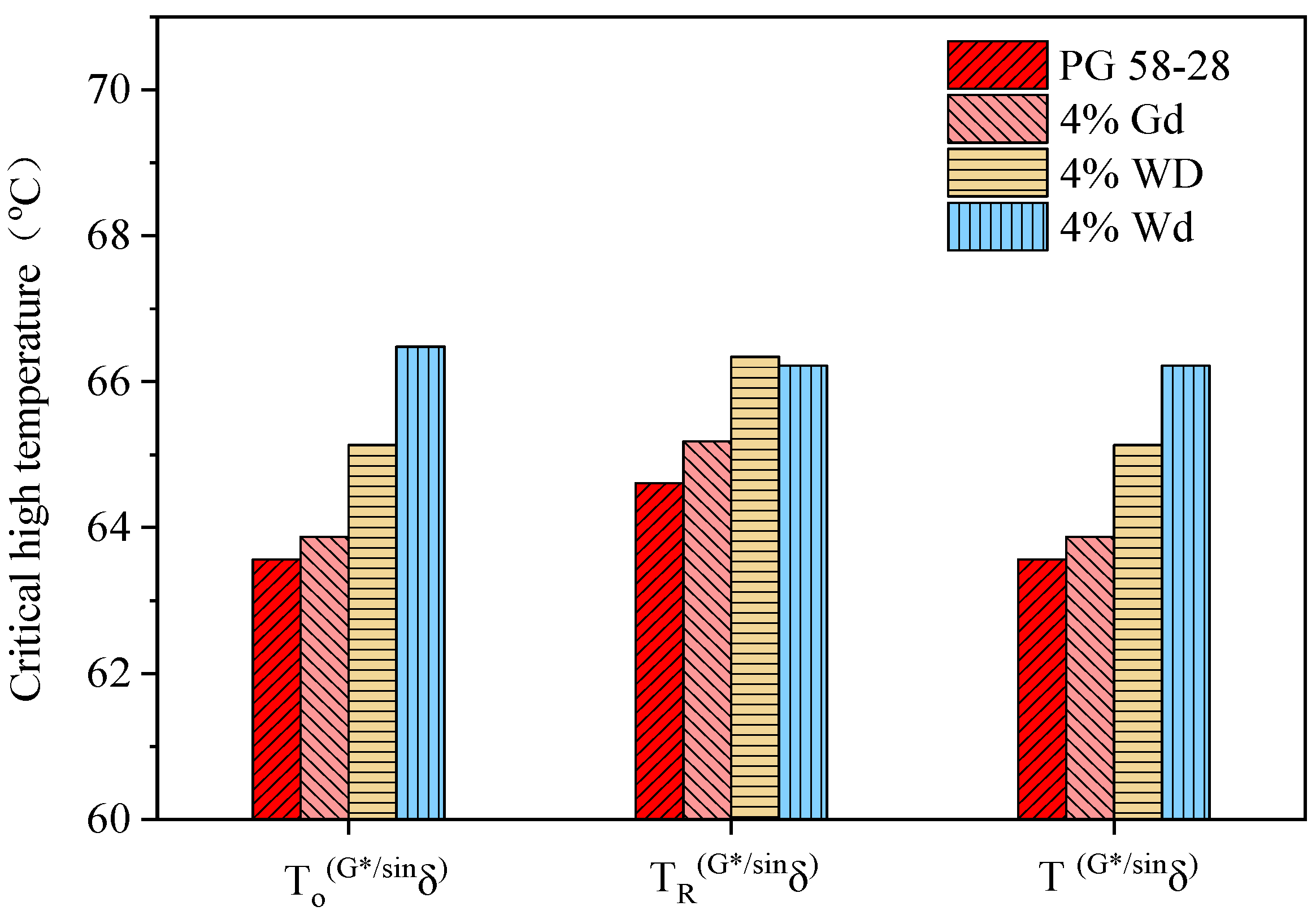
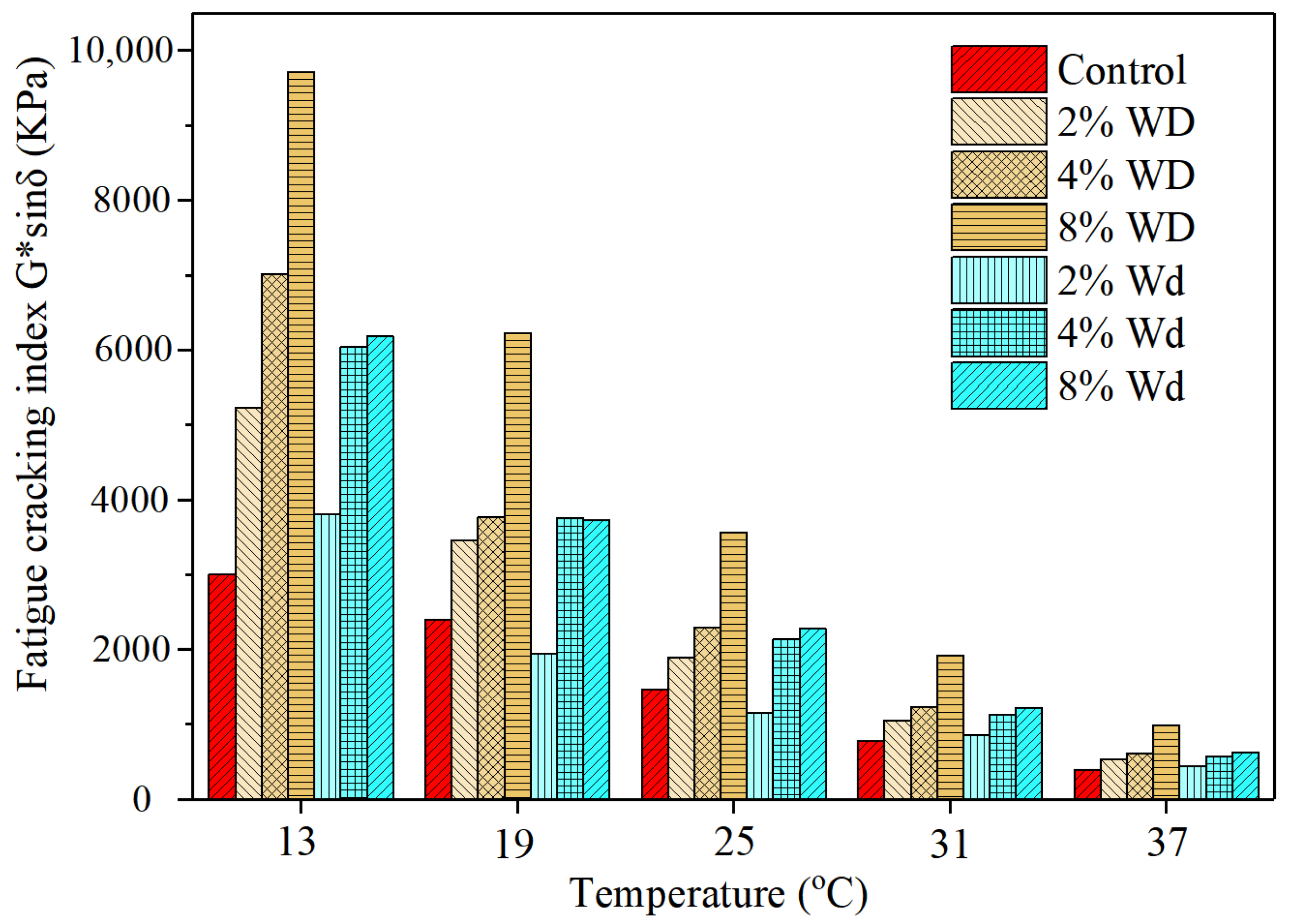
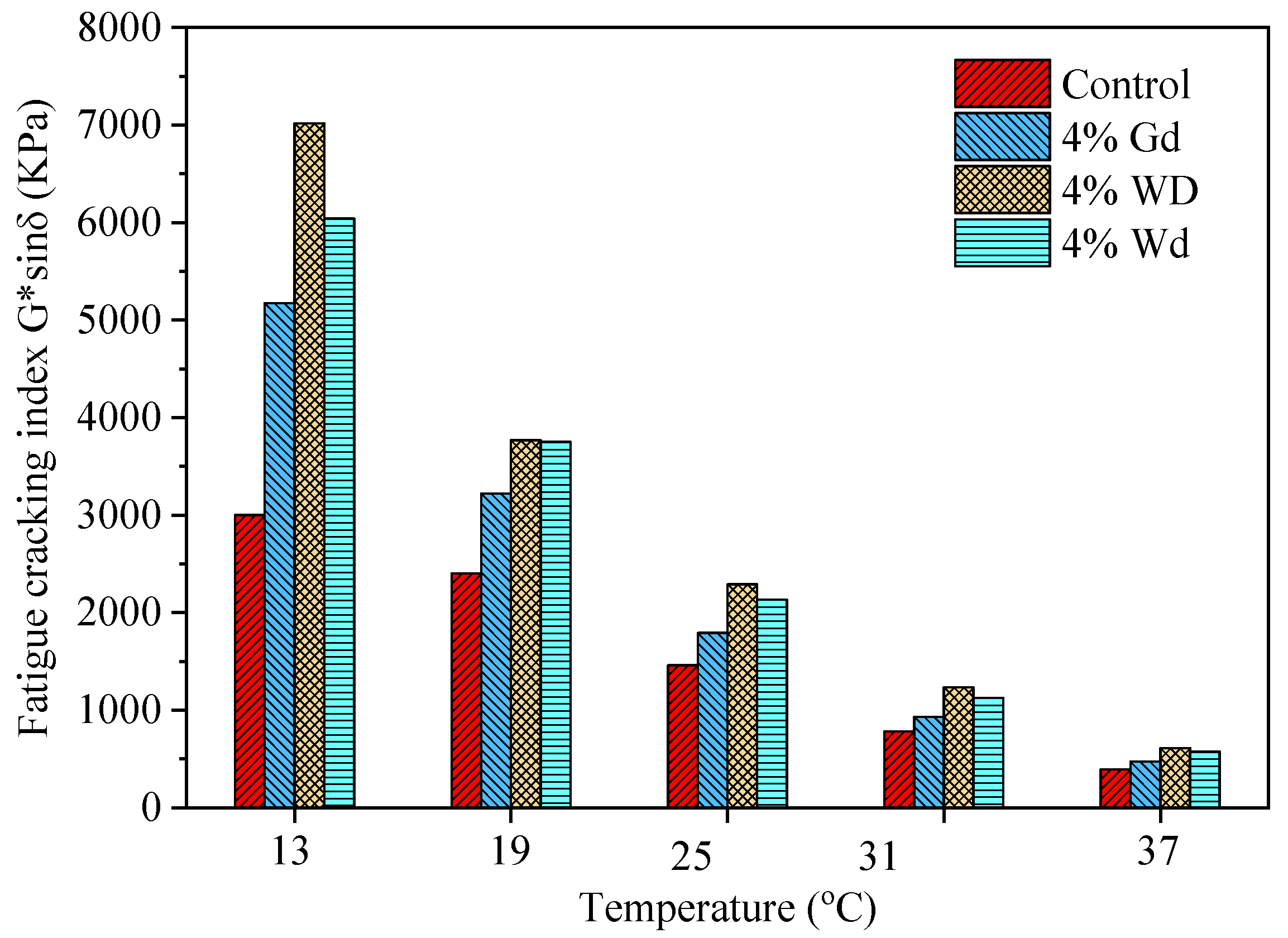
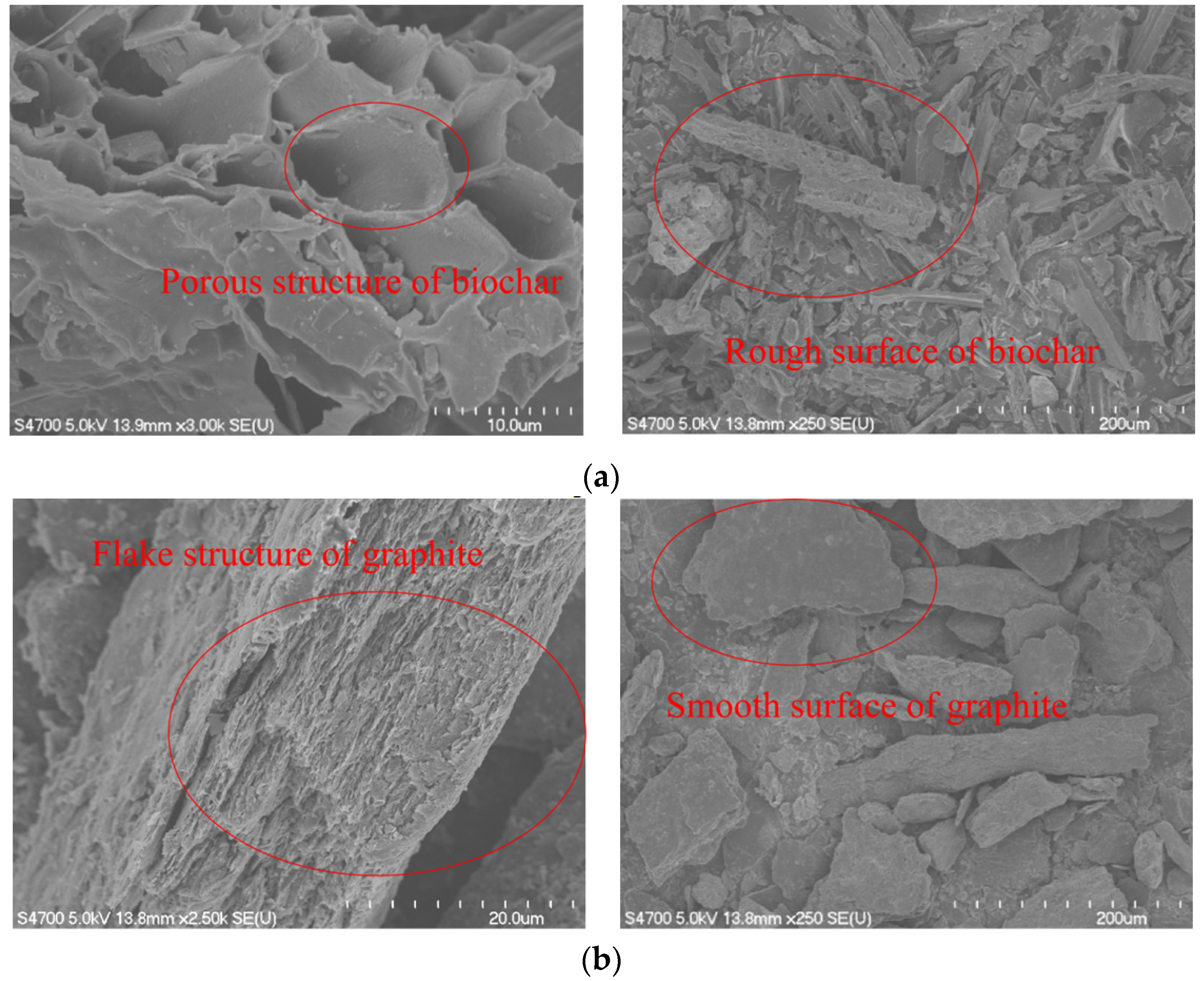
| Evaluation Index | Result | Specification Requirements | Specification |
|---|---|---|---|
| Specific gravity | 1.03 | - | - |
| Rotational viscosity (135 °C, Pa·s) | 0.350 | <3.0 | AASHTO T316-13 |
| Rutting resistance factor of the original asphalt G*/sinδ (58 °C) (kPa) | 1.995 | >1.0 | AASHTO T315-12 |
| Rutting resistance factor of aging asphalt after RTFOT G*/sinδ (58 °C) (kPa) | 5.018 | >2.2 | AASHTO T315-12 |
| m-value (−18 °C) | 0.31 | >3.0 | AASHTO T313-12 |
| Asphalt Type | Instruction |
|---|---|
| PG 58-28 | Petroleum asphalt |
| 2% WD | Biochar-modified asphalt, with 2% of biochar mixing amount, in 75–150 μm particle size |
| 4% WD | Biochar-modified asphalt, with 4% of biochar mixing amount, in 75–150 μm particle size |
| 8% WD | Biochar-modified asphalt, with 8% of biochar mixing amount, in 75–150 μm particle size |
| 2% Wd | Biochar-modified asphalt, with 2% of biochar mixing amount, in 0–75 μm particle size |
| 4% Wd | Biochar-modified asphalt, with 4% of biochar mixing amount, in 0–75 μm particle size |
| 8% Wd | Biochar-modified asphalt, with 8% of biochar mixing amount, in 0–75 μm particle size |
| 4% Gd | Graphite-modified asphalt, with 4% of biochar mixing amount, in 0–75 μm particle size |
| Source | df | Mean Square | Statistic Value (F) | Significance Probability (p) |
|---|---|---|---|---|
| Corrected model | 10 | 57.482 | 129.509 | 0.000 |
| Intercept | 1 | 247,350.122 | 557,285.216 | 0.000 |
| Type of modifier | 1 | 0.172 | 0.388 | 0.535 |
| Mixing amount of biochar | 2 | 0.986 | 2.222 | 0.116 |
| Particle size of biochar | 1 | 0.491 | 1.106 | 0.297 |
| Source | df | Mean Square | Statistic Value (F) | Significance Probability (p) |
|---|---|---|---|---|
| Corrected model | 7 | 8.709 | 43.976 | 0.000 |
| Intercept | 1 | 52,912.657 | 267,169.545 | 0.000 |
| Type of modifiers | 1 | 8.789 | 44.379 | 0.000 |
| Mixing amount of biochar | 2 | 10.056 | 50.775 | 0.000 |
| Particle size of biochar | 1 | 3.721 | 18.788 | 0.000 |
| Source | df | Mean Square | Statistic Value (F) | Significance Probability (p) |
|---|---|---|---|---|
| Corrected model | 9 | 18,420,737.266 | 28.445 | 0.000 |
| Intercept | 1 | 100,839,554.363 | 155.714 | 0.000 |
| Type of modifiers | 1 | 20,424.173 | 0.032 | 0.860 |
| Mixing amount of biochar | 2 | 6,459,913.709 | 9.975 | 0.000 |
| Particle size of biochar | 1 | 6,210,405.133 | 9.590 | 0.004 |
Publisher’s Note: MDPI stays neutral with regard to jurisdictional claims in published maps and institutional affiliations. |
© 2022 by the authors. Licensee MDPI, Basel, Switzerland. This article is an open access article distributed under the terms and conditions of the Creative Commons Attribution (CC BY) license (https://creativecommons.org/licenses/by/4.0/).
Share and Cite
Zhang, R.; Wang, H.; Ji, J.; Wang, H. Viscoelastic Properties, Rutting Resistance, and Fatigue Resistance of Waste Wood-Based Biochar-Modified Asphalt. Coatings 2022, 12, 89. https://doi.org/10.3390/coatings12010089
Zhang R, Wang H, Ji J, Wang H. Viscoelastic Properties, Rutting Resistance, and Fatigue Resistance of Waste Wood-Based Biochar-Modified Asphalt. Coatings. 2022; 12(1):89. https://doi.org/10.3390/coatings12010089
Chicago/Turabian StyleZhang, Ran, Haoxiang Wang, Jie Ji, and Hainian Wang. 2022. "Viscoelastic Properties, Rutting Resistance, and Fatigue Resistance of Waste Wood-Based Biochar-Modified Asphalt" Coatings 12, no. 1: 89. https://doi.org/10.3390/coatings12010089
APA StyleZhang, R., Wang, H., Ji, J., & Wang, H. (2022). Viscoelastic Properties, Rutting Resistance, and Fatigue Resistance of Waste Wood-Based Biochar-Modified Asphalt. Coatings, 12(1), 89. https://doi.org/10.3390/coatings12010089








